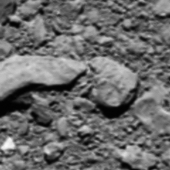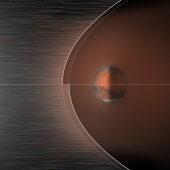ESA Science & Technology - News Archive
News archive
News archive
On 5 October 2017, the largest moon of Neptune will pass in front of a distant star. This rare event will temporarily block the star's light from Earth and provide an excellent opportunity to study the moon's intriguing atmosphere. Data from ESA's Gaia mission is allowing astronomers to precisely plan their observations.
Published: 3 October 2017
A molecule once thought to be a useful marker for life as we know it has been discovered around a young star and at a comet for the first time, suggesting these ingredients are inherited during the planet-forming phase.
Published: 2 October 2017
Scientists analysing the final telemetry sent by Rosetta immediately before it shut down on the surface of the comet last year have reconstructed one last image of its touchdown site.
Published: 28 September 2017
This oddly-shaped galactic spectacle is bursting with brand new stars. The pink fireworks in this image taken with the NASA/ESA Hubble Space Telescope are regions of intense star formation, triggered by a cosmic-scale collision. The huge galaxy in this image, NGC 4490, has a smaller galaxy in its gravitational grip and is feeling the strain.
Published: 28 September 2017
A long radar boom that will probe below the surface of Jupiter's icy moons has been tested on Earth with the help of a helicopter.
Published: 26 September 2017
The Herschel mission, a trailblazing space observatory that provided a unique view of our cosmos during its almost four years of operations, leaves a legacy of treasured data, thousands of scientific papers, as well as a new generation of astronomers who cut their professional teeth on this remarkable endeavour.
Published: 21 September 2017
With the help of the NASA/ESA Hubble Space Telescope, a German-led group of astronomers have observed the intriguing characteristics of an unusual type of object in the asteroid belt between Mars and Jupiter: two asteroids orbiting each other and exhibiting comet-like features, including a bright coma and a long tail.
Published: 20 September 2017
Delving deep into the history of our cosmos, the Herschel Space Observatory scrutinised hundreds of thousands of star-forming galaxies, peering back in time to when the Universe was less than one billion years old.
Published: 20 September 2017
During almost four years of observing the cosmos, the Herschel Space Observatory traced out the presence of water.
Published: 19 September 2017
Surveying the sky for almost four years to observe the glow of cold cosmic dust embedded in interstellar clouds of gas, the Herschel Space Observatory has provided astronomers with an unprecedented glimpse into the stellar cradles of our Galaxy.
Published: 18 September 2017
The international Cassini mission has concluded its remarkable exploration of the Saturnian system in spectacular style, by plunging into the gas planet's atmosphere.
Published: 15 September 2017
Astronomers have discovered that the well-studied exoplanet WASP-12b reflects almost no light, making it appear essentially pitch black. This discovery sheds new light on the atmospheric composition of the planet and also refutes previous hypotheses about WASP-12b's atmosphere. The results are also in stark contrast to observations of another...
Published: 14 September 2017
Scientists have used ESA's Venus Express to characterise the wind and upper cloud patterns on the night side of Venus for the first time–with surprising results.
Published: 14 September 2017
The international Cassini mission reaches its dramatic finale this Friday by plunging into Saturn's atmosphere, concluding 13 years of exploration around the ringed planet.
Published: 12 September 2017
In past decades, spacecraft have sent back huge amounts of complex data about Mars, providing a wealth of information about the planet. More than ever, the scientific community needs a way to sift through, compare, and analyse these data, prompting the development of two new tools for exploring the surface of the Red Planet.
Published: 7 September 2017
The international Cassini-Huygens mission has explored Saturn and its rings and moons for 13 years, and will conclude by plunging into the planet's atmosphere next week. This article highlights some of the mission's exciting discoveries led by European teams.
Published: 6 September 2017
An international team of astronomers used the NASA/ESA Hubble Space Telescope to estimate whether there might be water on the seven earth-sized planets orbiting the nearby dwarf star TRAPPIST-1. The results suggest that the outer planets of the system, including the three planets within the habitable zone, might still harbour substantial amounts...
Published: 31 August 2017
The movements of more than 300 000 stars surveyed by ESA's Gaia satellite reveal that rare close encounters with our Sun might disturb the cloud of comets at the far reaches of our Solar System, sending some towards Earth in the distant future.
Published: 31 August 2017
As the energetic particles of the solar wind speed across interplanetary space, their motion is modified by objects in their path. A study, based on data from ESA's Mars Express orbiter, has thrown new light on a surprising interaction between the planet Mars and supersonic particles in the solar wind.
Published: 22 August 2017
Proposals are solicited for observations with XMM-Newton in response to the seventeenth Announcement of Opportunity, AO-17, issued 22 August 2017. This AO covers the period May 2018 to April 2019 and is open to proposers from all over the world. The deadline for proposals is 6 October 2017 (12:00 UTC).
Published: 22 August 2017
—
20 Items per Page




















